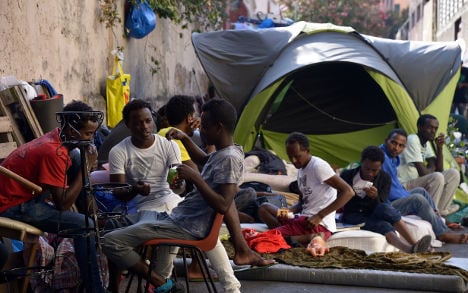There are up to 300 of them at a time, mostly from Eritrea, Ethiopia and Sudan. Most have left reception centres to stay here a night or two before continuing their journeys north, some unaware the borders are closed to them, others determined to try again after failed attempts to cross.
“When the landings (of migrant boats to Italy) resumed in the spring, we gradually saw a tent pop up here, then two, then three,” said Andrea Costa, a volunteer with the Baobab Experience NGO, which until last year ran a shelter on Via Cupa.
The site was repossessed in November. As discussions with the city council over an alternative spot dragged on, the migrants simply settled out in the open and the cul-de-sac now boasts sleeping bags, pots and pans and even a table-football table.
“Watch your backs!” cry volunteers as they bring a heavy saucepan of boiling rice to a serving station, where men, women and children line up in single file to fill their plastic plates, the air heavy with the smell of fried onions.
The chefs are two young Swiss who brought their mobile kitchen to the street after doing stints in the migrant camps of Calais and Grande-Synthe in France, as well as Italy's Lake Como near the Swiss border, where some 500 migrants sleep in a park.
In some areas tempers are wearing thin as the wait to journey on to northern Europe increases: in Ventimiglia on the Italy-France border, 600 people are sheltering in a Red Cross centre. Others are put on buses and escorted back to centres down south.
In Milan some 3,300 people are camped out in the station or nearby streets in the hope of getting on a train north.
More than 100,000 migrants have been plucked off unseaworthy vessels in the Mediterranean and brought to Italy this year, and while the numbers are similar to last year, the context is radically different.
“The borders in the north are closed, migrants can't get through,” Costa told AFP.
'Almost a game'
“We're worried small Idomenis will develop in Ventimiglia, Como, Milan and Rome,” he said, referring to the vast informal refugee camp on the Greek-Macedonian border that was cleared by riot police in June.
While the 35,000 or so migrants who passed through the Baobab Centre last year managed for the large part to leave Italy, Costa sees an increasing number of people this year forced to return to Via Cupa after being turned back at the border.
For returners, life in the cul-de-sac has become a sort of “Groundhog Day”, where, as in the film, they re-live the same experience – resting, refuelling and planning yet another attempt at the crossing — over and over.
Maroma, a 19-year old from Sudan, has already made it over the Ventimiglia crossing but was stopped by police and returned to a centre in Taranto, at Italy's southern tip. Once there, he simply began the journey north again.
Fellow Sudanese Mahmad Karim pulls a notebook out from under his mattress. He wants to learn English and proudly shows off his attempts at learning and writing the Roman alphabet, from 'A' to 'Z'.
“My difficulty is the language, not the borders,” he says with a laugh.
Everyone here has spent weeks, months or even years on the road, trekking across the desert, through Libya and across the Med.
“They have no money and nothing to lose. Trying to cross the border becomes almost a game,” Costa said.
Under pressure from the European Union, Italy has stepped up efforts since 2015 to identify each and every migrant it rescues, preventing them under EU rules from applying for asylum in another European country.
In exchange, some were supposed to be relocated to other EU countries, but the programme has struggled to get off the ground.
The result is a sharp jump in the number of asylum seekers blocked in Italy – more than 144,000 currently reside in reception centres, compared to 66,000 in 2014 and 103,000 in 2015.
They may be stuck, but the determination to journey onwards is still very much alive.
“We need information more than food,” Costa says. And after dinner, out come the maps of Europe and a quick geography lesson for those planning to set off the next day, including the unwelcome news that Italy shares no borders with Britain.



 Please whitelist us to continue reading.
Please whitelist us to continue reading.